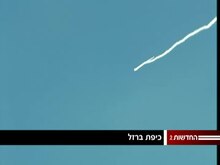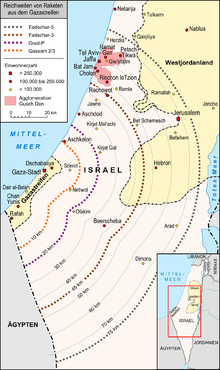Iron Dome
| Iron Dome | |
|---|---|
| General Information | |
| Type | Missile defense system |
| Local name | Iron Dome |
| Country of origin |
|
| Manufacturer | Rafael Advanced Defense Systems Ltd |
| development | 2005 |
| Commissioning | 2010 |
| Working time | in service |
| Unit price | $ 50 million per battery, $ 20,000 per missile, as of 2014 |
| Technical specifications | |
| length | 3.00 m |
| diameter | 160 mm |
| Combat weight | 90 kg |
| drive | Solid rocket engine |
| speed | 700 m / s |
| Range | ~ 17 km |
| Service ceiling | 10,000 m |
| Furnishing | |
| steering | Inertial navigation platform |
| Target location | Radar seeker |
| Warhead | 11 kg fragmentation warhead |
| Detonator | Proximity and impact fuses |
| Weapon platforms | Trailer with 20 missiles |
| Lists on the subject | |
Iron Dome ( Hebrew כיפת ברזל kipat barzel 'iron dome' or 'iron dome') is an Israeli mobile missile defense system (C-RAM: Counter Rocket, Artillery and Mortar-System) developed by Rafael Advanced Defense Systems Ltd. was developed for defense against short-range missiles .
Development and funding
The increasing threat to Israel from incoming missiles, especially by Kassam -Kurzstreckenraketen of Hamas from the Gaza Strip , by Katyusha -Kurzstreckenraketen of Hezbollah from southern Lebanon and Iranian long-range missiles , led to the development of various defense systems. While the Arrow system is used against long-range missiles, the Iron Dome is used to defend against artillery missiles with a range of 5 to 70 kilometers. The David's Sling system for fighting missiles with a range of 70 to 250 kilometers is also under development.
According to Rafael, the system should be able to repel short-range missiles as well as 155-mm artillery shells regardless of the time of day and weather; several targets can be fought at the same time.
In February 2007, the Israeli Defense Minister Amir Peretz selected the system as the missile defense system of the Israel Defense Forces against short-range missiles. The total cost should amount to 1.5 billion shekels (approx. 375 million US dollars ), the cost per interceptor missile to 35,000 to 50,000 US dollars; Since two missiles are usually launched at the same time at each target, the cost per launch is up to 100,000 US dollars; Iron Dome is therefore a comparatively inexpensive solution. Costs and development time could be reduced by using existing components of the SPYDER air defense system. In addition, the USA supported development and procurement with 205 million US dollars in 2011. In August 2012, the USA received further support of 70 million US dollars.
The first successful test was carried out on July 7, 2008. On July 19, 2010, the Israeli armed forces reported the system as operational; the first two batteries were stationed in November 2010 at Sderot on the border with the Gaza Strip. In March 2011, the station was stationed in Be'er Scheva and near Ashkelon .
As of July 2014, nine units were put into service, four of which are currently stationed around the Gaza Strip. Israel plans to expand the stock to a total of 15 systems over the next few years.
As of 2019, the US Army has two systems and will order additional units if necessary.
The system is now successfully in use in Israel and, according to the Israel Defense Forces, intercepts 90% of attacks.
technology
A system consists of an EL / M-2084 - Multi-Mode-Radar (MMR), a control center (BMC) and up to four launch units (MFU) for 20 interceptor missiles each. The radar from IAI Elta Systems detects the launch of a missile, calculates its trajectory and transmits this information to the control center, which uses it to determine the point of impact of the missile. The system works fully automatically and, depending on the programming, takes into account the protection zones defined by coordinates. If the target point falls in one of the protection zones and therefore justifies the costs of an interception measure, one or more interceptor missiles are launched after manual confirmation. The interceptor is based on the Derby air-to-air missile and is named Tamir . It is equipped with a radar seeker head and a control stabilizer, which gives it a high degree of maneuverability. An iron dome battery can defend an area of 150 km² (a circle with a radius of around 7 km ) against missile and artillery attacks and detect up to six approaching objects at the same time. The mobile structure of the defense system allows it to be moved quickly to other regions of the country and is suitable for all weather conditions. The control center including the command post software was developed for Rafael by the Israeli company MPrest Systems. Future systems should also provide for the simultaneous detection of several missiles from two different directions and an extension of the interception distance.
commitment

The missile defense system was first put into operation on March 26, 2011 north of Beersheba. It was first used successfully on April 7, 2011 when it shot down a Grad rocket launched from the Gaza Strip . On this and the following days, a total of eight Grad rockets and one Qassam rocket were intercepted. According to an army spokesman, the hit rate was almost 100 percent. During an escalation in March 2012, 110 rockets were fired from the Gaza Strip into southern Israel in the first three days. Over 30 of them were intercepted. In July 2014, numerous rockets from the Gaza Strip were intercepted by Iron Dome. According to IDF, 2968 rockets had been fired at Israel by August 1, 2014 , of which 547 were intercepted by Iron Dome.
Operation Pillar of Cloud
During Operation Cloud Pillar in November 2012, Iron Dome was of enormous importance: US security experts said that without the missile defense system, Israel would probably have invaded Gaza in the first week of the operation. The fifth Iron Dome battery was put into operation near Tel Aviv during the first days of the operation. The whole system intercepted artillery rockets of various types, such as the Fajr-5 (Kassam M-75) , fired from the Gaza Strip during Operation 421 . According to the Israeli military, this corresponded to an interception rate of 84%. Studies from 2013 claim, however, that the hit rate could be much lower. According to an MIT study, Iron Dome has only been able to destroy 5% of the attacking warheads.
On November 15, 2015, the Iron Dome failed, killing three people in Kiryat Mal'achi in rocket fire from the Gaza Strip . On November 21, 2012, Hamas and Israel agreed on a ceasefire. US President Obama then promised renewed help with the expansion of Iron Dome.
According to the manufacturer Rafael, Iron Dome has achieved a hit expectation of 90% and by the end of 2019 over 2000 successful kills should have been achieved.
distribution
-
 Israel - As of 2019, there are 10 batteries with around 30 systems in use.
Israel - As of 2019, there are 10 batteries with around 30 systems in use. -
 United States - 2 batteries with 12 launchers and 480 interceptor missiles.
United States - 2 batteries with 12 launchers and 480 interceptor missiles.
Web links
- Manufacturer's website
Individual evidence
- ↑ http://www.ynetnews.com/articles/0,7340,L-4541496,00.html
- ↑ a b c d e Ballistic Missile Defense: Iron Dome Description (December 5, 2012). In: mostlymissiledefense.com. Mostly Missiledefense.com, accessed June 11, 2018 .
- ↑ Iron Dome. Defense Against Short Range Artillery Rockets. (No longer available online.) In: rafael.co.il. Rafael Advanced Defense Systems Ltd., archived from the original on April 12, 2011 ; accessed on April 12, 2011 .
- ↑ Yaakov Katz: Iron Dome successful in downing 75% of rockets. Jerusalem Post, accessed November 17, 2012 .
- ↑ George Spziro: Israel uses new missile defense system. NZZ. April 12, 2011, accessed April 13, 2011 .
- ↑ Ron Ben-Yishai: RAFAEL selected to produce rocket interception system. (No longer available online.) In: ynet.co.il. Yedioth Media, February 1, 2007, archived from the original on April 12, 2011 ; accessed on April 12, 2011 .
- ^ Lars Olberg: Iron Dome. Missile monitor. (No longer available online.) In: missilemonitor.blogspot.com. October 19, 2007, archived from the original on April 12, 2011 ; accessed on April 12, 2011 .
- ↑ http://www.defense.gov/news/newsarticle.aspx?id=117354
- ↑ Yuval Azoulay and Haaretz Correspondent: Israeli arms company successfully tests Iron Dome anti-Qassam missile. Israel News. (No longer available online.) In: haaretz.com. Haaretz Daily Newspaper, July 7, 2008, archived from the original on April 12, 2011 ; accessed on April 12, 2011 .
- ↑ Iron Dome system passes final tests. (No longer available online.) In: jpost.com. The Jerusalem Post, July 19, 2010, archived from the original on April 12, 2011 ; accessed on April 12, 2011 .
- ↑ https://www.jpost.com/Israel-News/US-Army-doesnt-want-any-more-Iron-Dome-systems-604807
- ↑ http://www.businessinsider.com/hamas-claim-beat-iron-dome-missile-interceptor-israel-disagree-2019-5
- ↑ hairetz.com: Meet Israel's home-front hero: Iron Dome July 18, 2014, accessed on August 2, 2014.
- ↑ Gili Cohen, Yanir Yagna, Avi Issacharoff, Barak Ravid and Reuters: Iron Dome intercepts Gaza rockets over Ashdod, as escalation continues for third day. In: Haaretz.com. Haaretz, March 11, 2012, accessed on March 11, 2012 .
- ↑ Israel posts the "Iron Dome" missile defense system. (No longer available online.) In: orf.at. ORF Online and Teletext, March 27, 2011, archived from the original on April 12, 2011 ; Retrieved April 12, 2011 .
- ↑ Anshel Pfeffer, Yanir Yagna: Iron Dome successfully intercept Gaza rocket for first time. In: Haaretz.com. Haaretz, April 7, 2011, accessed April 13, 2011 .
- ^ Yaakov Katz: Iron Dome works in combat, intercepts Katyusha rocket. (No longer available online.) In: jpost.com. The Jerusalem Post April 7, 2011, archived from the original April 12, 2011 ; accessed on April 12, 2011 .
- ↑ Matthias Chapman: What good is Israel's new wonder weapon? News abroad: Middle East & Africa. (No longer available online.) In: derbund.ch. Der Bund, April 11, 2011, archived from the original on April 12, 2011 ; Retrieved April 12, 2011 .
- ^ Hanan Greenberg: Israel presents: Iron Dome in action. In: jpost.com. The Jerusalem Post, April 10, 2011, accessed April 13, 2011 .
- ↑ Gili Cohen, Yanir Yagna, Avi Issacharoff, Barak Ravid: Iron Dome intercepts Gaza rockets over Ashdod, as escalation continues for third day. In: Haaretz.com. Haaretz, March 11, 2012, accessed on July 14, 2014 .
- ^ Israel's Iron Dome intercepts rockets fired from Gaza. In: bbc.com. BBC, July 13, 2014, accessed July 14, 2014 .
- ↑ http://www.jpost.com/Operation-Protective-Edge/US-Senate-blocks-Iron-Dome-funding-to-Israel-369699
- ↑ Ralph Sina: US Military Aid for Israel: "Iron Dome" Instead of Invasion? (No longer available online.) In: tagesschau.de . ARD , November 20, 2012, archived from the original on November 24, 2012 ; Retrieved November 20, 2012 .
- ↑ Israel's Iron Dome. In: The Wall Street Journal . November 25, 2012. Retrieved November 26, 2012 .
- ↑ UPI: Iron Dome shootdown rate disputed ( Memento of May 12, 2014 in the Internet Archive ) accessed March 25, 2013
- ↑ David Ax: Israel's Iron Dome is more like an iron sieve - Reuters, July 25, 2014
- ↑ Gil Ronen: Did Iron Dome Malfunction Let In Lethal Rocket? In: israelnationalnews.com . IsraelNationalNews , November 19, 2012, accessed November 21, 2012 .
- ↑ Michael Borgstede: Middle East: Israel reserves the right to use the ground in Gaza. In: welt.de . November 21, 2012, accessed October 7, 2018 .
- ^ Rafael Advanced Defense Systems: IRON DOME Family
- ^ The International Institute for Strategic Studies (IISS): The Military Balance 2019 . United Kingdom, 2019, p. 348. ISBN 978-1-85743-988-5 .
- ↑ Breaking Defense: Army Reboots Cruise Missile Defense: IFPC & Iron Dome
- ↑ Defensenews: It's official: US Army inks Iron Dome deal



